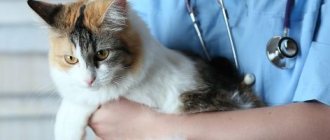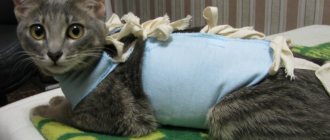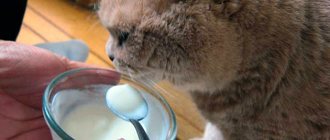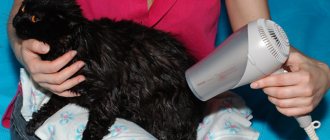To protect your cat from new pregnancies, she can be sterilized (in a cat this means removal of the ovaries) or castration (removal of the ovaries and uterus). Veterinarians recommend sterilizing a cat if mating is not planned. The fact is that in the absence of mating, periodically recurring estrus over time depletes the pet’s nervous system.
Indications for sterilization
Sometimes cats develop diseases that simply require castration:
- Inflammation of the reproductive organs, characterized by damage to their walls.
- Infections and injuries that can be inherited by offspring.
- Pyometra. This pathology is characterized by inflammatory processes of the uterus, which leads to increased accumulation of pus.
- Hematometra. Accumulation of blood in the uterus.
- Hydrometer. Accumulation of fluid in the uterus.
- Endomteritis. Inflammation of the uterus.
All these indications boil down to one conclusion - urgent castration of the animal is required (i.e. removal of both the ovaries and the uterus). Only with endometritis can you not rush into surgery and simply give your cat special medications and injections. However, at some point an intervention will still be required.
Sterilization during heat
This phenomenon also occurs. However, it is even more rare than spaying a pregnant cat.
The operation can be performed only in cases of real need, where sterilization itself will be a lesser evil than the cause. During heat, a cat experiences a lot of blood loss. And the pet may simply not survive the operation .
© shutterstock
Is it possible to sterilize a cat that has given birth?
It is best to sterilize a cat not after giving birth, but immediately before the first heat, i.e. about a year. However, castration is also possible after childbirth, for the indications listed above or if there is no need for mating.
Also read the article about when is the best time to spay a cat.
Sometimes a cat is operated on during pregnancy. But this is carried out exclusively on the recommendation of a veterinarian and is practiced extremely rarely due to possible complications.
Post-operative cat care
As with any surgery, recovery time is an important element of successful sterilization. Therefore, as soon as the cat leaves the operating room, the following measures should be kept in mind:
- Cleaning the spay wound daily : is extremely important to prevent infections and promote healing, you should do this three times a day with gloves, gauze, iodopovidone or rifocin, depending on what your veterinarian has prescribed.
- Prevent access to the wound : Avoid scratching, licking, or attempting to remove stitches by using an Elizabethan collar or a corset-style fabric cover that you can make at home from a cotton shirt cut into a rectangle large enough to cover the stomach and torso.
- Avoid sudden movements of the cat or intense physical activity to avoid damaging the stitches.
- Provide adequate diet to maintain ideal weight. It is also important to place food in easily accessible places to avoid unnecessary effort.
Regarding post-operative breastfeeding, keep in mind that:
- Stitches located on the abdomen or side can partially hinder breastfeeding due to the discomfort they cause.
- There have been reports of deaths of nursing kittens after their mother was spayed. It is believed that the reason lies in the anesthesia transmitted through breast milk.
Mr. Cat recommends: what to feed a cat after sterilization
A pet that has undergone surgery needs special care and extra attention.
The pet is only allowed water for the entire day after surgery. On the second day, the cat is fed meat, fish or wet food twisted through a meat grinder.
The main thing to remember is that after sterilization, the cat’s digestive system noticeably weakens, so it cannot cope with solid food. Food should not be hot or cold. The food is heated until warm.
You can also learn more about how to feed a cat after spaying or neutering, and what food is best to give her.
Preparing for surgery
Many owners think that their only job is to bring their cat to the veterinarian and pick it up after surgery. In reality, the pet needs to be prepared for surgery and conditions created for it during rehabilitation.
- Choosing a clinic. A few weeks before the proposed procedure, you need to start looking for a good and reputable veterinarian. You need to understand that highly qualified and experienced specialists do not provide services cheaply.
- Diet. Both before the operation and during rehabilitation, the pet should follow a diet. If the cat eats natural food, then the diet should be based on boiled beef and poultry. If the animal is accustomed to dry food, then you need to buy premium food.
- Medical supplies . It is necessary to purchase a collar that will prevent the animal from licking and biting the operated area. You should also ask your veterinarian what medications to buy for treating postoperative sutures. Treatment is carried out within 10 days after the procedure. To prevent the cat from tearing the seams with its claws, many owners purchase a belly bandage.
- Place for rehabilitation . The recovery from anesthesia is individual for each animal: some cats regain consciousness a couple of hours after the operation, while others remain lethargic and drowsy all day. For comfortable rehabilitation, a cat needs to build a soft bed and place it in a quiet and shaded place. During the recovery period, the cat should not be pulled or shouted at.
- Painkillers. The animal will experience pain in the abdomen for several days. Therefore, it is impossible to do without anesthetics. Among human medicines, Papaverine, No-shpa, and Ketonal are suitable for animals. The dosage and therapeutic course are prescribed by the veterinarian. It is forbidden to choose painkillers for your pet at your own discretion, since many human medications are dangerous for cats.
Contraindications
In some cases, sterilization is contraindicated. Causes:
- Allergy to certain medications.
- The disease and the period immediately after it.
- Recent injury.
- Individual intolerance to anesthesia.
In any case, the cat must first be examined by an experienced veterinarian and give an opinion. Additional examination may be required to identify other contraindications.
Castration is not recommended after 10 years of age, since the risk of postoperative complications is very high. The same applies if the cat is too young; surgery can slow down the development of the animal.
Special Considerations
If your veterinarian gives you the go-ahead to spay your cat after giving birth, you'll need to step in and help take care of her babies. Watch each furball during feeding to make sure they are all eating and drinking. They are still learning to feed themselves, and may need a bottle from time to time until the mother cat is healthy enough to nurse again, if she needs to nurse at all. Typically, by 5 to 6 weeks of age, kittens should be perfectly happy eating just moistened food.
Complications
Complications can be expressed in the form of lethargy and drowsiness, enlarged mammary glands, hernia, lack of appetite, abnormal bowel movements, changes in body temperature, the appearance of a rash, bleeding of the suture, heavy breathing, accompanied by wheezing, pallor or redness of the mucous membrane. Typically, all these symptoms go away on their own within a day or two.
Before surgery, the cat is given an anesthetic drug of minimal toxicity that does not have a negative effect on the body. Despite this, anesthesia causes its own complications: blood pressure rises, metabolism slows down, the pulse may become irregular, and allergies may appear. The result can be heart failure or even anaphylactic shock.
Features of the postpartum period in cats
The postpartum period is a difficult time for a cat. Her body needs strength to restore and feed her offspring.
At this time, changes occur in the hormonal background caused by pregnancy:
- the level of progesterone, the “calming” hormone, drops sharply;
- the production of prolactin, which is responsible for the formation of milk, increases;
- Estrogen, the main hormone responsible for sexual desire, increases.
The genitals return to their previous (non-pregnant) state. Normally, the uterus in cats completely acquires its previous size 9-12 weeks after the birth of kittens.
Cat age and sterilization
When asked when it is better to sterilize a cat, veterinary experts answer: it would be good to do it at 7-8 months. It is believed that it is during this period of animal development that all organ systems are fully formed, the cat is ready to conceive, but there has not yet been pregnancy.
Puberty of a pet can occur earlier or later than the specified period. To determine the optimal interval, you will need to periodically show her to the veterinarian and do examinations. Performing surgery on an adult cat or a very young one is fraught with serious complications and health problems in the future. Early surgery may cause developmental delays in the animal.
Why can’t you sterilize your pet while nursing kittens?
As can be concluded from the statements of experts, in most cases, the timing of the operation varies depending on whether the cat is nursing kittens or not. By the way, this directly affects this procedure. Even if an animal has lost its pets for some reason, for example, all the kittens died or were drowned, then the pet owner must wait at least fourteen days, after which the operation can be performed. This information is confirmed by many qualified veterinarians, so we cannot not trust it.
As for the castration procedure itself when feeding kittens, this should not be done under any circumstances. According to experts, carrying out this process while feeding babies can lead to injury to the mammary glands and even serious infection of the wound after castration. If the cat is feeding kittens, then no matter how long you wait after giving birth, you cannot begin this process while she is nursing.
Among other things, in the case of sterilization, there is a very high probability of affecting large and very important blood vessels for the life of the pet. They are located next to the mammary gland, so they can be affected very easily. In addition, if you carry out the castration procedure while breastfeeding, there is a risk that the cat’s milk will disappear. Then, in order for the kittens to survive, you will have to independently buy them special food for newborns and feed them on your own.
So, by doing sterilization while feeding you:
- you greatly risk the health of the animal, even to the point of its death;
- Doom yourself to regularly buy food for kittens;
- you will have to make your own feeding schedule and participate directly in the feeding itself.
But in some cases, if there is an uncastrated cat nearby, the cat has a very high risk of getting health problems even without sterilization. It’s no secret that estrus can begin even a week or two after giving birth. Thus, contact with a male cat will harm the cat even more than the castration procedure. Therefore, in this case, each owner will have to decide what to do. The best option is to isolate the animal after birth.
Veterinarian recommendations
Below are some recommendations based on the most frequently asked questions about this surgery.
- Before performing surgery, the age of the cat must be taken into account. Intervention performed too early or late entails many complications.
- Nursing cat mothers need to delay sterilization until the end of the lactation period. The body will fully recover in at least 2 weeks after the kittens are taken from their mother.
- If the cat does not feed the offspring, the operation cannot be performed earlier than a month after birth.
- A cat needs to give birth at least once before being spayed - a common misconception. This in no way affects the health of the pet or the operation. If you do not need kittens in the future, you need to sterilize at the earliest possible date.
- Before 4 weeks of pregnancy, it is quite possible to carry out sterilization, if necessary.
- Get tested and get the necessary vaccinations, they will help protect your pet from infection.
Emergency cases
There are situations when an animal has to be operated on during pregnancy. This problem doesn't happen often.
Indications for sterilization when bearing offspring are:
- serious pathologies requiring immediate surgical intervention;
- high probability of death of the animal during childbirth;
- offspring unwanted by the owner;
- injuries and infectious diseases in a cat, due to which cubs may be born with defects.
Sometimes cats may need emergency sterilization
Serious and life-threatening pathologies that require surgical intervention even during pregnancy and in the first days after childbirth are:
- pyometra – inflammation of the uterus, accompanied by the accumulation of large amounts of pus;
- hematometra - accumulation of blood in the uterine cavity;
- hydrometer - filling the uterine cavity with liquid;
- endometritis – inflammation of the uterine mucosa.
There is no other treatment other than sterilization for the above diseases.
Sterilization or castration: what is the difference?
When sterilizing a cat, one is limited to simple tubal ligation.
The genital organs remain functioning normally after surgery. Sterilization does not affect the animal’s attraction to the opposite sex, instincts do not decrease, their intensity does not change in any way. A cat can mate, but it will not produce offspring.
During castration, all organs responsible for reproduction are completely removed. The uterus and ovaries are removed (ovariohysterectomy) or only the ovaries (oophorectomy).
Previously, veterinarians only removed the ovaries of young nulliparous cats. However, now in most cases an ovariohysterectomy is performed, since removal of the ovaries alone does not avoid gynecological problems.
Laparoscopic sterilization is becoming increasingly important. Its advantages:
- Minimal trauma. During the operation, a small incision is made. Surgical instruments are inserted through it and manipulations are performed.
- Small seam size. It is also possible to apply cosmetic stitches - in this case they will not need to be removed later.
- There is no need for complex postoperative wound treatments.
- Less pain after surgery due to minor skin damage.
In a typical operation, two types of sutures are applied. Firstly, these are internal sutures that are placed on the peritoneum, abdominal muscles; A special absorbable material is used, which does not need to be removed after surgery.
There are also external seams. They do not dissolve and need to be removed after about 10-12 days.
There is also an external cosmetic suture with its own special application technique and the use of absorbable material.
In sterilized animals, the reproductive system continues to function even though they cannot have offspring. Hormonal storms negatively affect them.
Neutered cats are still susceptible to stress, as well as a high risk of developing diseases of the genitourinary system. In such cases, the cat loses weight, does not eat and behaves aggressively towards the owner.
Neutered animals live on average several years longer than sterilized ones. Among castrated cats, true long-livers are often found.
After the procedure, they behave much more friendly and adequately, do not mark their territory and do not scream. Due to the absence of genital organs, the risk of any diseases occurring in them is completely eliminated.
Some animals may require this operation for health reasons, so it is better to take the necessary measures while your pet is still young, strong and will tolerate anesthesia and surgery well.
How long should it take before sterilization after childbirth?
Caring owners should be aware that not all cats can be defertilized. The animal must be fully formed and physically healthy, so the operation is not performed on small kittens and older cats. The essence of sterilization is to remove the uterus and appendages (ovaries and fallopian tubes). The time of the operation depends on the feeding of the kittens: 2-4 weeks need to be waited for a non-breastfeeding cat and 2-3 months for a nursing mother cat. The minimum period between births for non-lactating cats is 3 months, for nursing cats it is about 4-5, so the optimal time for sterilization after the birth of kittens is 2 months. Contraindications for surgery:
- immediately after childbirth;
- during feeding;
- during postpartum estrus;
- during pregnancy more than 4 weeks.
It is impossible to carry out the intervention immediately after lambing, since the uterus has not yet acquired its previous appearance and hormonal disorders have not recovered. During pregnancy, the uterus changed its shape, size and grew thicker with blood vessels, so any surgical manipulations in the postpartum period can stimulate heavy bleeding. In addition, it loses its elasticity, making it difficult for the surgeon to apply a ligature, which also stimulates hemorrhage.
It is not advisable to sterilize during postpartum heat. The operation itself does not threaten the animal, but the stitches heal much more difficult. Also, you should not allow your pet to come into contact with an uncastrated cat at this time, which is even more harmful than sterilization itself. Hasty haste in this matter is a great risk to the life of the pet.











